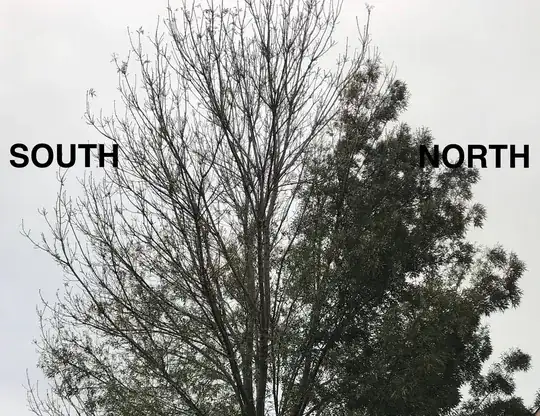The vascular system is hopefully healthy all around the girth of your tree. It is a THIN sheet that encircles the trunk just below the bark which is there to protect the live cells just beneath. This cambium where the vascular system resides is so thin one can easily score beneath the bark with a pocket knife to girdle/kill the entire tree. The rest of the trunk is dead, like dead skin cells that aren't going to slough off so they become tree rings or the old, dead plumbing that is continually replaced each Spring with a new alive cambium. They give structure and strength to the trunk like a house yet need no maintenance.
This first article is great talking about the 'Big Suck'...how the vascular system works against gravity to do the plumbing of Redwoods and Eucalyptus trees 100's of feet high. Fascinating. Just to give you a better understanding of a plant's vascular system It takes more than osmosis to cause the movement of water and chemicals UP to the leaves and the food produced by the leaves via photosynthesis DOWN to the roots for storage when plants are 100's of feet in the air. Roots gather the water and chemicals from the soil to the Xylem in the Trunk that takes it up to the leaves (sometimes stems) for use by chloroplasts/chlorophyll for photosynthesis to make carbohydrates for the plant's food for growth and repair and reproduction. I don't like calling the chemistry 'nutrients' because people associate the word 'nutrient' with food. Fertilizer and chemicals are not 'food' for a plant. The Phloem is the other part of the plumbing within this cambium that takes this food DOWN to the roots for storage and dispersion where that food is needed.
Here is another simple primer on the two systems that are in the vascular system about Xylem (up) and Phloem (down) Maple syrup, rubber...when tapped are examples of the Phloem part, the stuff the tree's photosynthetic factories made for use by the tree that travels down to the roots for storage and dispersion to the tree's new growth, reproductive growth, damage repair...like a big city)...
Xylem and Phloem
The Big Suck getting water up 100's of feet
Just to clarify vascular system...the vascular system or the trunk's bark is not thicker on the south side so to speak. But the side of the plant that has the most leaves doing the most work and also receiving the largest temperature changes from day to night get the most 'food', water and are abscised earliest to prevent damage from the temperature extremes.
vascular system
pictures of cambium in cross section
The tree or shrub or even herbaceous perennials will have the leaves that get the most sun get the most water, chemicals necessary to continue photosynthesis. They will also be the first to be 'told' chemically to abscise or fall from the tree. Deciduous trees shed leaves for winter as leaves are the most fragile of plant parts. Next are the roots for being fragile. If roots are in a pot the roots are then subjected to temperatures that will kill the plant. Being in the ground protects the roots. Abscision helps deciduous plants survive in colder environmental niches with winters. Evergreen plants are either conifers or have very thick leaves that can withstand the winters. That is why you find evergreens more in the tropics.
There is a problem with getting too warm on one side of the tree and then dealing with too cold (at night). This will burst living cells. The leaves...and bark/cambium on the north side do not suffer the extremes as the south side of a plant. Fruit tree growers actually paint the bark of the south side of the tree to reflect the light/heat to keep the temperature of the cambium cells from bursting and killing the vascular system on the south side of the tree's trunk.
So the tree is actually protecting itself by abscising the leaves on the south side first. The temperature differences between night and day would signal the abscison.
xylem and phloem
